Hello geektimes! Today, I want to talk about Lenovo's new tablet, which was presented in Barcelona at the MWC 2017 exhibition. And do it from a somewhat unusual angle - from the perspective of a parent whose child (children) is also not averse to panning on a bright touch screen.

Intro
When a child enters the family, it changes a lot around, including the relationship with gadgets. When a child is still very young, he unconsciously reaches for your smartphone in his hands - simply because he is colorful, bright, makes sounds, and so on. Time flies, so very soon the child begins to want their gadgets.
This can be treated differently: someone taboos any gadgets almost to school age (or even later), someone buys “especially for children” gadgets, and someone with clenched teeth takes a normal smartphone or tablet and gives it to the mercy - if only the child in it sat quietly and not interfere. Each of the approaches has the right to life, this is a topic for a separate discussion, but we believe that here, as elsewhere, the golden mean is good: a child’s access to a smartphone / tablet should be, but under the prism of caring parents. Simply put - the gadget is more likely to be than not (and if not, very soon your child will begin to feel deprived of recess with classmates).
And here comes the dilemma: give your child your gadget or buy a separate one? And if it is separate, then it is “inexpensive-child” and which is not a pity to break, or is something “normal” so that the child does not psyche from the brakes and does not break his eyes on the poor screen? And if yours, then how to distinguish between your (business and personal) and children's (play) spaces? Buy immediately armor-piercing device, or the usual, but with unkillable accessories?
If we talk about tablets, it seems that Lenovo has managed to find the answer to the dilemmas mentioned above and make quite a “family” tablet. His name is
Tab 4 8 Plus .
The first acquaintance with the device makes it clear that this is not a child's trinket, but a very adult device, even more so - this is a full-fledged tablet with excellent characteristics.
Box
In general, Lenovo has presented not one tablet, but a whole new line of
Tab 4 of 4 devices - Tab 4 8, Tab 4 8 Plus, Tab 4 10 and Tab 4 10 Plus. As it is easy to guess, they differ in screen diagonals (8 or 10 inches), but we decided to take for publication the most, in our opinion, interesting and versatile model -
Tab 4 8 Plus .
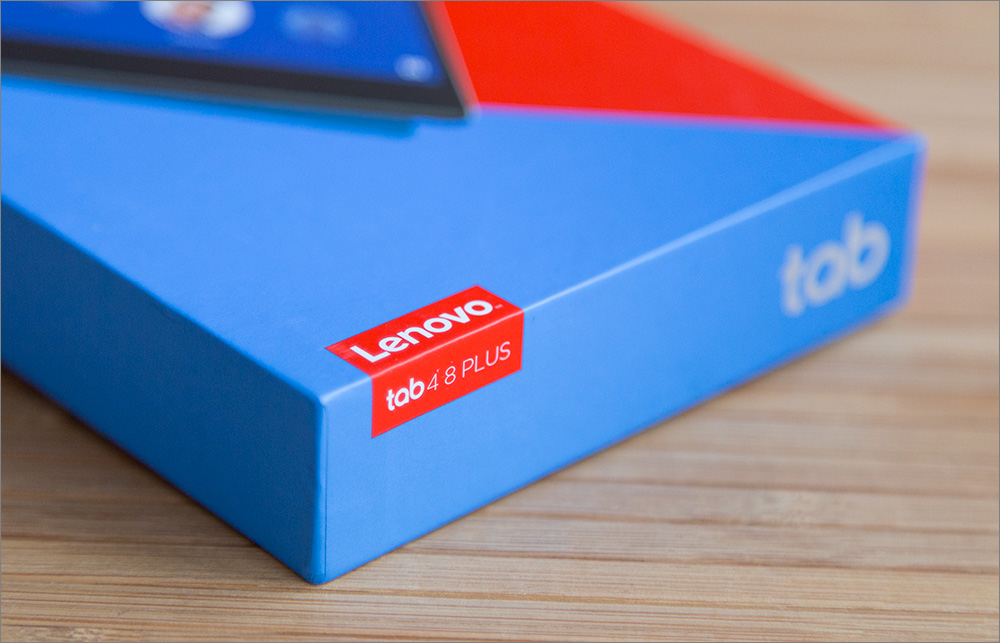
Why her? Because 10 inches is, of course, good, but very often “too big” - it is sometimes inconvenient to carry around, as well as hard to hold (especially a small child). But 8 - this is not a big 10 inches, but no longer small 7. Golden mean! Plus in the title says about some additional buns, probably in terms of performance - this means it is not about flagship features (otherwise it would have been written in large quantities), but not like “simpler model” - another golden midpoint! :)

A box of high-quality colored cardboard, according to the form factor, looks more like a box of chocolates “Cow”. But inside there is something inedible (although some children eat), namely: the tablet itself, some papers, a USB adapter for mains power and USB-C-wiring.
Kid's pack
Optionally for the tablet, you can purchase the so-called "Kid's pack" - a separate box specifically for tablets of the Tab 4 series, the composition of which is as follows:

- Protective bumper
- Two scratch-resistant stickers (3M Controltac)
- Film filter on the screen;
- Fibrotryapochka with a smoothing plate (for film and stickers).
One sticker is yellow with airplanes, the second is turquoise, in the color of a bumper. Tactile, they resemble oilcloth.
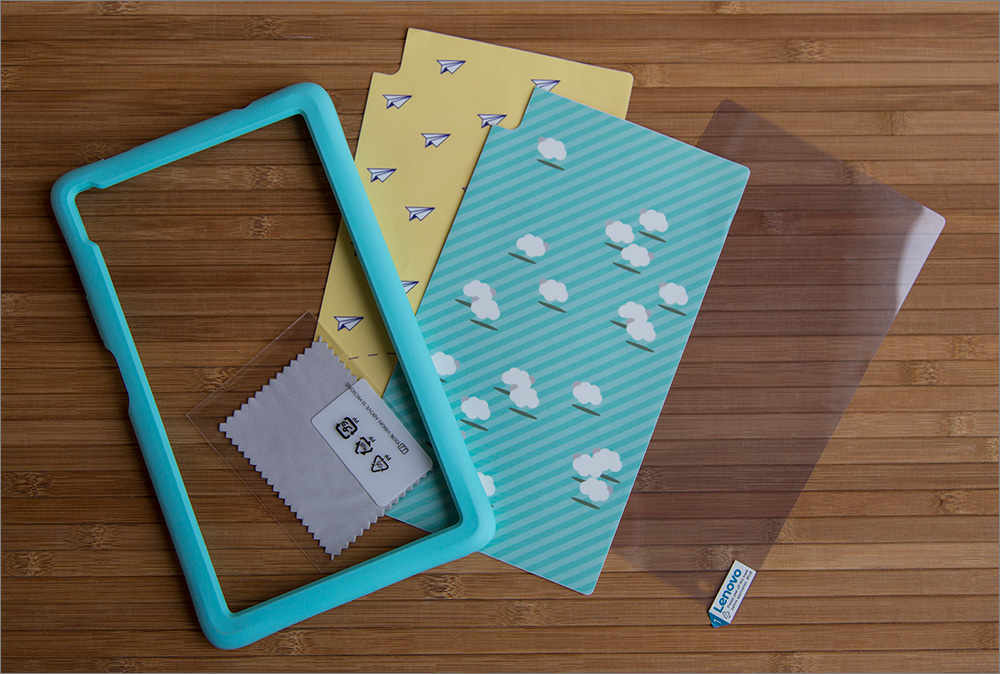
The bumper itself visually seems to be rubber, but to the touch it is not as elastic — rather, like softened plastic. Very pleasant to the touch, like soft touch. Inside there are small stiffeners, which make the structure quite strong and there is no doubt that it will protect the device from unnecessary injuries.


For the 10-inch model there is a Productivity Pack - with an external keyboard case.
Appearance
Externally, the tablet is knocked out of the usual for Lenovo products (take the same Yoga for comparison) and looks more like, khm, at devices of one other company: a thin body, glass surfaces on both sides, and a metal frame around the perimeter. However, if that company has forgotten on the tablets, and similar materials for the case have proven themselves well, then why not.
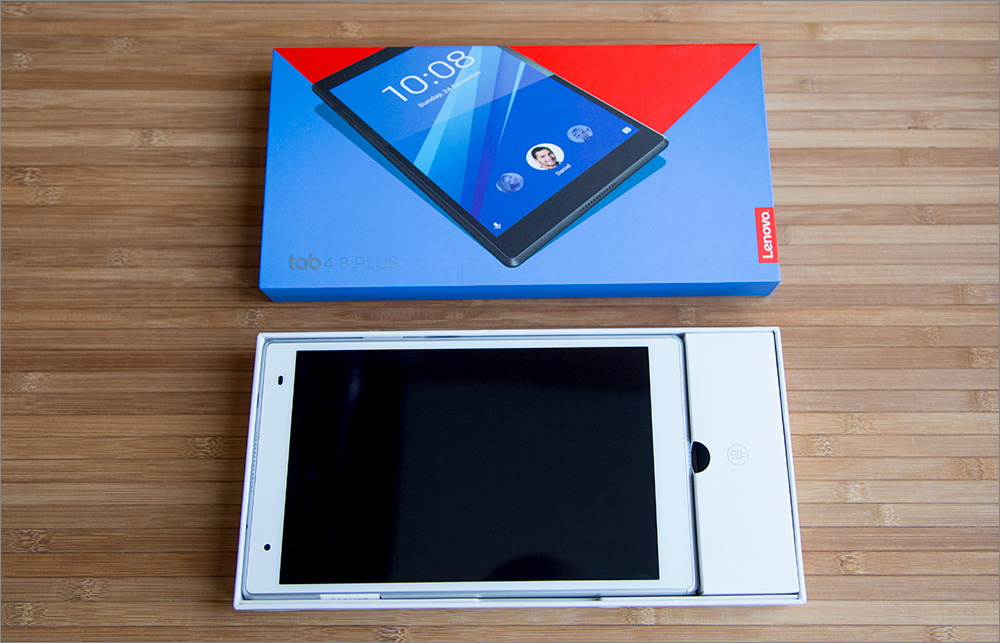
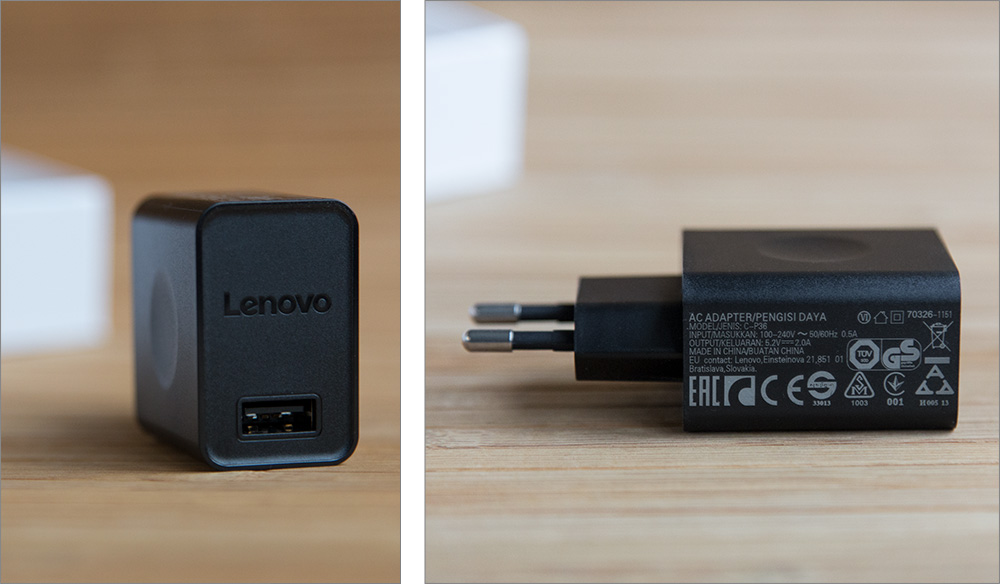
The frame is either semi-circular, or slightly angular, with holes for stereo speakers, a few buttons and even less numerous connectors (USB for charging and mini-jack).
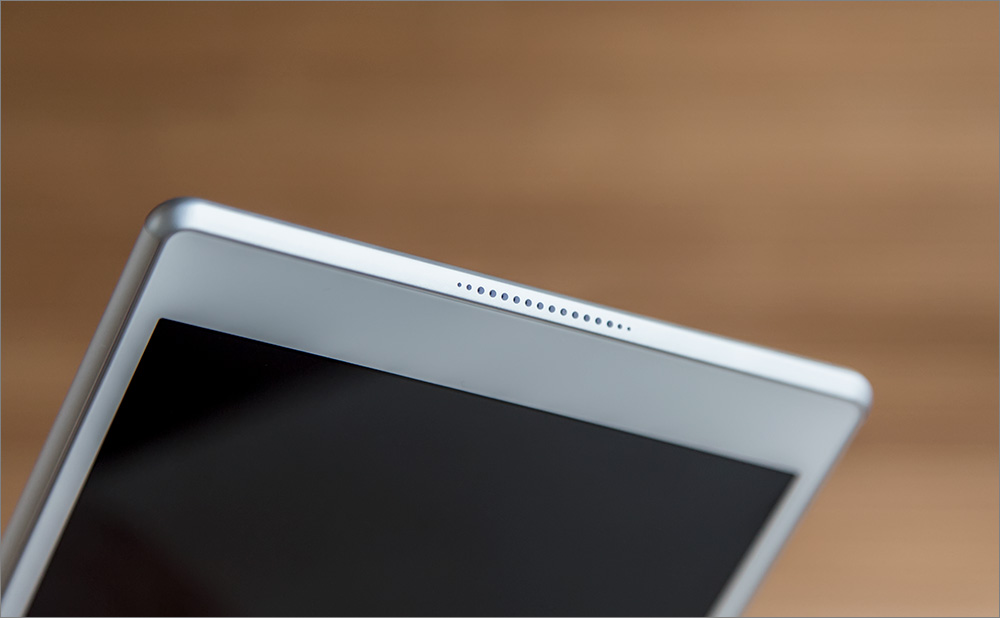

There are only two buttons (more precisely, three): the inclusion and two-way volume rocker. And the power button is not simple, but combined with a fingerprint scanner, which is quite convenient.

Behind a tight cap there is a slot into which a memory card (microSD) and a nanoSIM card (or two at once, but then without a memory card) are inserted at the same time (into a special bar).



Front - front camera and light sensor, as well as the status LED (which is visible only during operation), there are no buttons under the screen.
Rear camera with flash, flush with the body, does not protrude.

Glass - how good is this tablet material? We believe that it is good, for the reason that, unlike the same smartphone, the tablet still spends more time at home: standing or lying somewhere, occasionally choosing to go for a walk (in a case, in a special compartment of a backpack, etc.). While the smartphone from glass is exposed to rougher daily impacts.
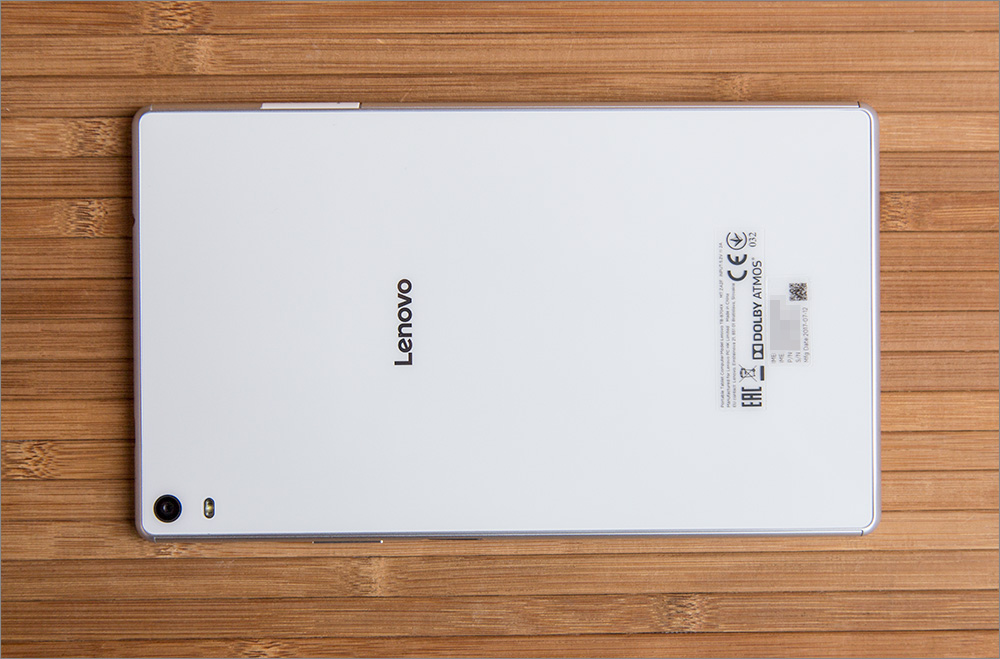
Specifications
In this regard, models with a plus in the title are more interesting than models without it.
All Tab 4 tablets are based on Qualcomm SoC, but in the younger models they are four-core Snapdragon 425, while in Plus-versions they are eight-core Snapdragon 625. In conventional models, the screen resolution is 1280x800, in Plus, the resolution is 1920x1200. Memory - 2 GB of RAM and 16 GB for data, in Plus-versions - 3 GB of RAM for the 16 GB version and 4 GB for the version with 64 GB of memory. Also, cameras (2 and 5 megapixels versus 5 and 8), connectors (microUSB versus USB Type C) and battery (4,850 mAh for 8-inch tablets and 7,000 mAh for 10 ") are different. -version - this feature is useful for multi-user tablet use.
The exact name of the model from the review -
Lenovo TB-8704XIron
| Processor: Qualcomm MSM8953 Snapdragon 625 (eight cores, up to 2 GHz)
RAM: 3 or 4 GB
Graphics processor: Adreno 506
|
Display
| 8 ", 1920x1200 (283ppi), touchscreen, IPS, support for up to 10 touch points
|
Storage device
| 16 - 64 GB internal memory + up to 128 GB microSD
|
operating system
| Android 7.0 (Nougat)
|
Communication media
| Wi-Fi 802.11a / b / g / n / ac (2.4 and 5 GHz)
Bluetooth 4.2
Built-in GPS / A-GPS / GLONASS
Optional 3G / 4G support (available on models with an index of X)
Optional support for 2 SIM cards (available in models with index X)
|
Battery
| 4850 mAh
|
Weight, g
| 300
|
Dimensions, mm
| 123 x 210.6 x 7
|
Cameras
| Front: 5 Mp, with a constant focal length;
Rear: 8 megapixel, with autofocus and flash, video recording 1080p @ 30
|
Ports and connectors
| MicroSD connector, combined audio jack (3.5mm), USB Type-C,
|
Audio system
| Two front stereo speakers with Dolby Atmos technology
|
Other
| Fingerprint scanner
Fast charge
|
Colors
| Black or white
|
In practice
The first time to take the device in hand in portrait orientation is not very convenient - sometimes the finger scanner is touched with a thumb (with the subsequent slight vibration of the device). But when you set up authorization through a problem finger, the problem disappears :) In this orientation, it is convenient to read websites or books - there is a lot of things that fit. But it is much more convenient to keep the tablet in landscape orientation (for watching movies or playing games) - in this case, there are no accidental connections with the buttons, and under the thumbs on both sides there is a place for comfortable grip.
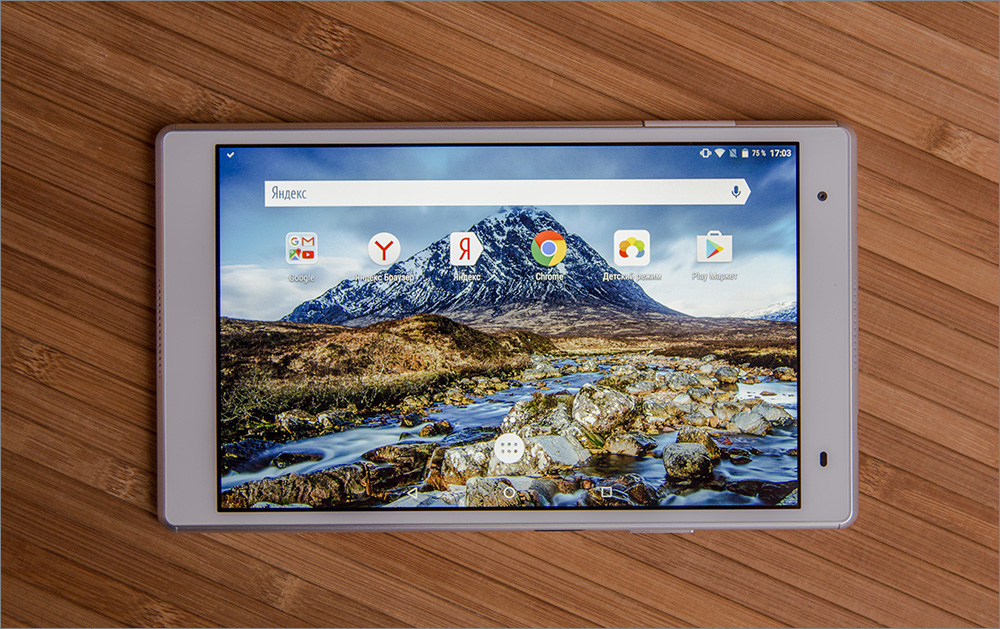
The fingerprint scanner works quite well: first, it recognizes almost without errors, and secondly, it unlocks the system very quickly (even if the device is turned off, just lean your finger, without pressing - in case of successful authorization, the tablet will immediately show the desktop of that account which the finger belongs to).
FullHD-resolution at eight inches looks very cool, the screen is bright, the colors are saturated - it’s nice to watch this screen yourself and show others. In general, the 8-inch screen is really enough for most tasks - be it watching movies, reading, playing games or surfing the web.
When you first turn on the user is waiting for almost naked Android 7.0 (as long as the update to 7.1.1 is available), no pre-installed and un-removable bells and whistles (except for MS office suite). But, surprisingly, only half of the 16 GB of memory is available (and 50 GB for the 64-gigabyte version), so if you take the younger model, do not forget to buy a memory card right away (feel free to add 1-2 thousand to the price of the device).
Animations are smooth, everything flies - there is enough performance, the device is practically not heated even when watching a video. If we talk about parrots, then in the popular Antutu Tab 4 8 Plus it scores almost 63500 points (3D - 12699, UX - 244285, CPU - 21104, RAM - 5394), but in general the article did not want to talk about it)
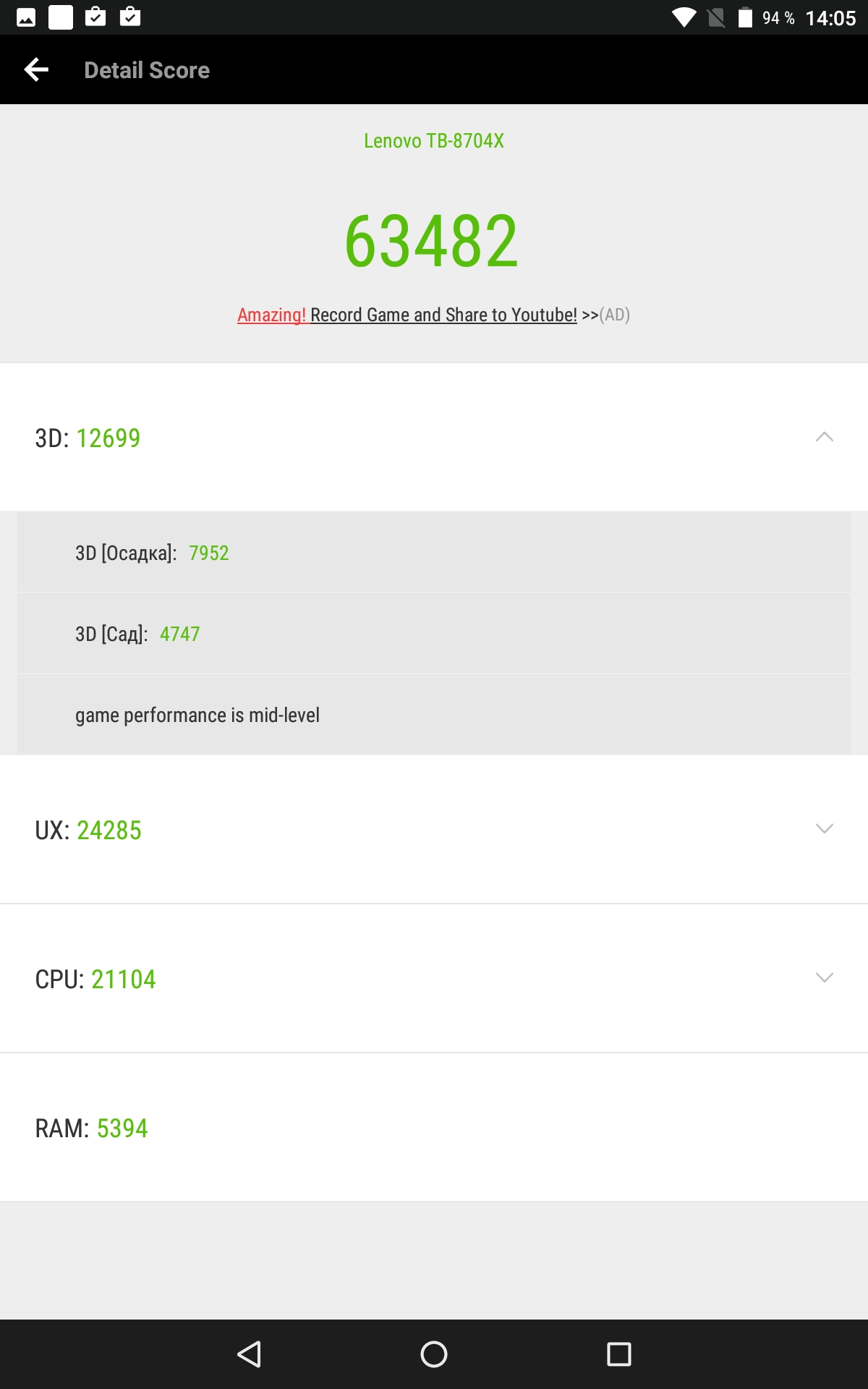
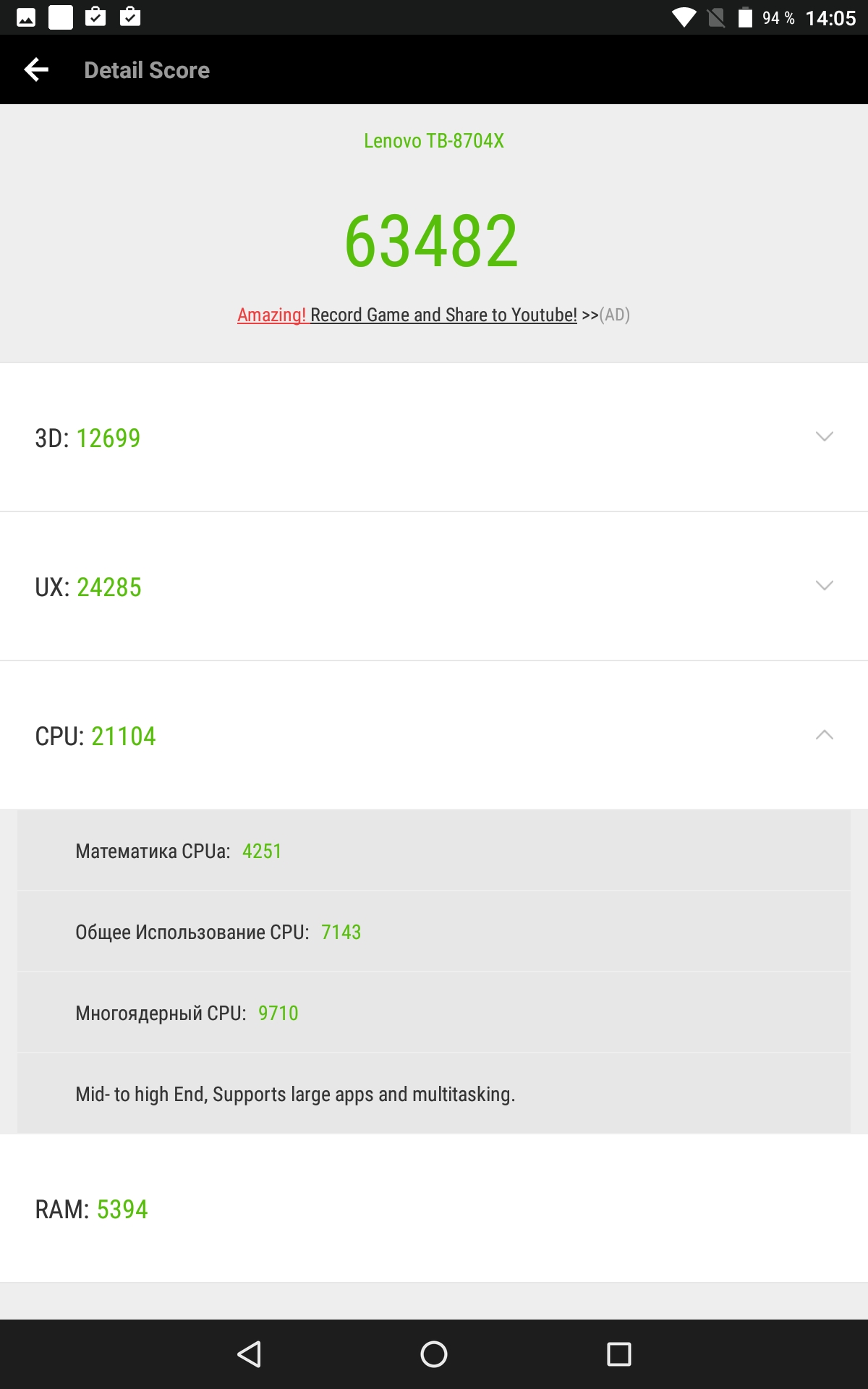
Child mode
Returning to the topic of children, mentioned at the beginning of the article ... The fact that there is enough tablet performance for viewing luntik and various arcade toys is understandable. Let's better see how Lenovo approached the creation of an ecosystem for several family members.
And everything is done simply - not at the expense of the “demo mode” (with the concealment of some data or applications), but at the expense of separate accounts, which can be several on the tablet at once (as in stationary OS): you can enter the necessary account or by password, or by fingerprint scanning. An account can be either an “adult” or a special “children’s” account over which the parents will have control.
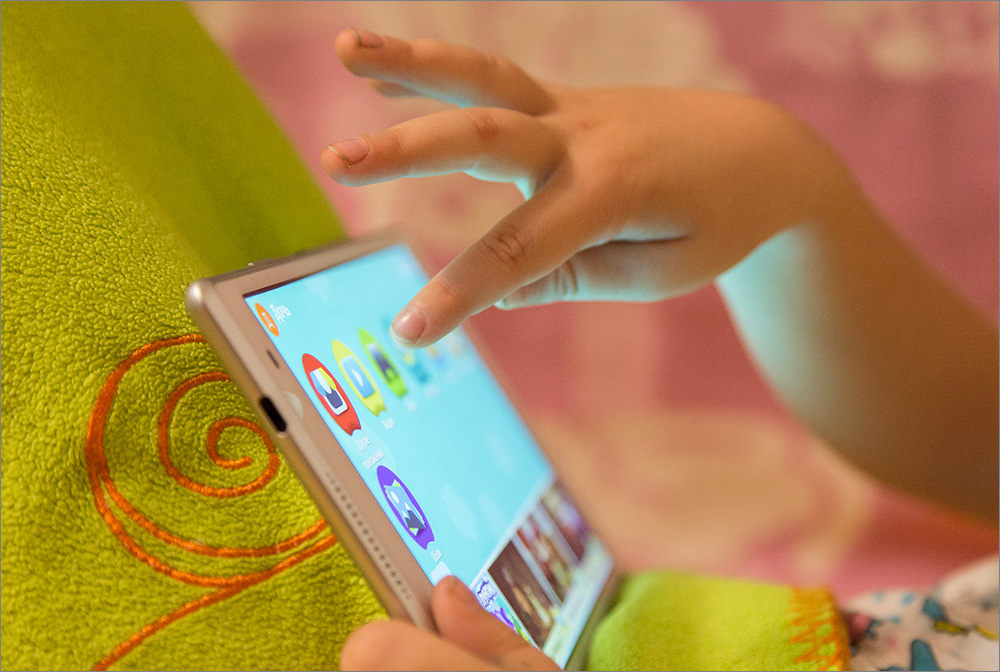
At the heart of the “child” account is the
KIDOZ app - The world's largest mobile network for kids. In short, this is what it is about:
On the main desktop there is an application “Child mode”, which allows you to add a child's profile - specify the name, date of birth, gender and avatar. Next, you can configure a time limit: set the usage time (no / 20 min / 30 min / 60 min / Random) and interval (no / 30 min / 60 min / Random). That is, you can almost introduce a “children's pomodoro”: 30 minutes on the tablet → 30 minutes break :) In the third step - the password of parental control. On the user list page for children, you can turn off calls and SMS.
Then you can switch to the child mode either through the lock screen (by selecting the created account), or through the same “child mode” of the parent account. Switching takes a couple of seconds).
Children's account is maximally fenced off from all sorts of misfortunes, so its functionality is rather severely limited: there are only 7 shortcuts on the desktop by default (you can turn them off if you wish).
 Other applications:
Other applications: allow you to download selected applications. It is not very clear who and how selected them, but a quick inspection of the selection showed that there is no treshak and the truth is not. But the range is not very large, mostly games.
Games: a section with HTML toys that work with an active Internet connection. "Out of the box" there are two dozen games - mostly unpretentious arcades, there is no direct training.
Video: perhaps the most useful section, which contains all kinds of videos, divided into categories. A kind of "YouTube for children." Useful not because there is something developing in it (although it is there), but because there is nothing superfluous in this section: no advertising, no pop-up windows, system functions, extra buttons, moronic videos about unpacking boxes (although children oooochen this look) and other potentially dangerous content.
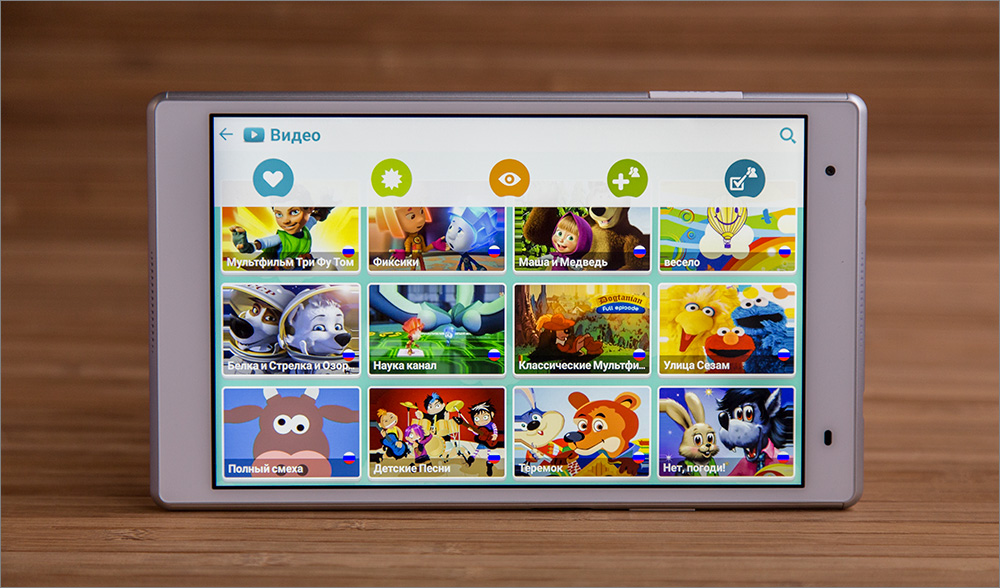
There are mainly cartoons: Masha and the Bear, Well, wait, branch of Soyuzmultfilm, Fixiki-Luntik-Smeshariki and other children's entertainment (any channel can be turned off through parental control). For comparison, run a regular YouTube app or a browser on the tablet and turn on some children's video followed by auto-play - after 10 minutes you will be surprised what will start playing and what will pop up in “maybe you will be interested”. And here even through the search for nothing “bad” is found.

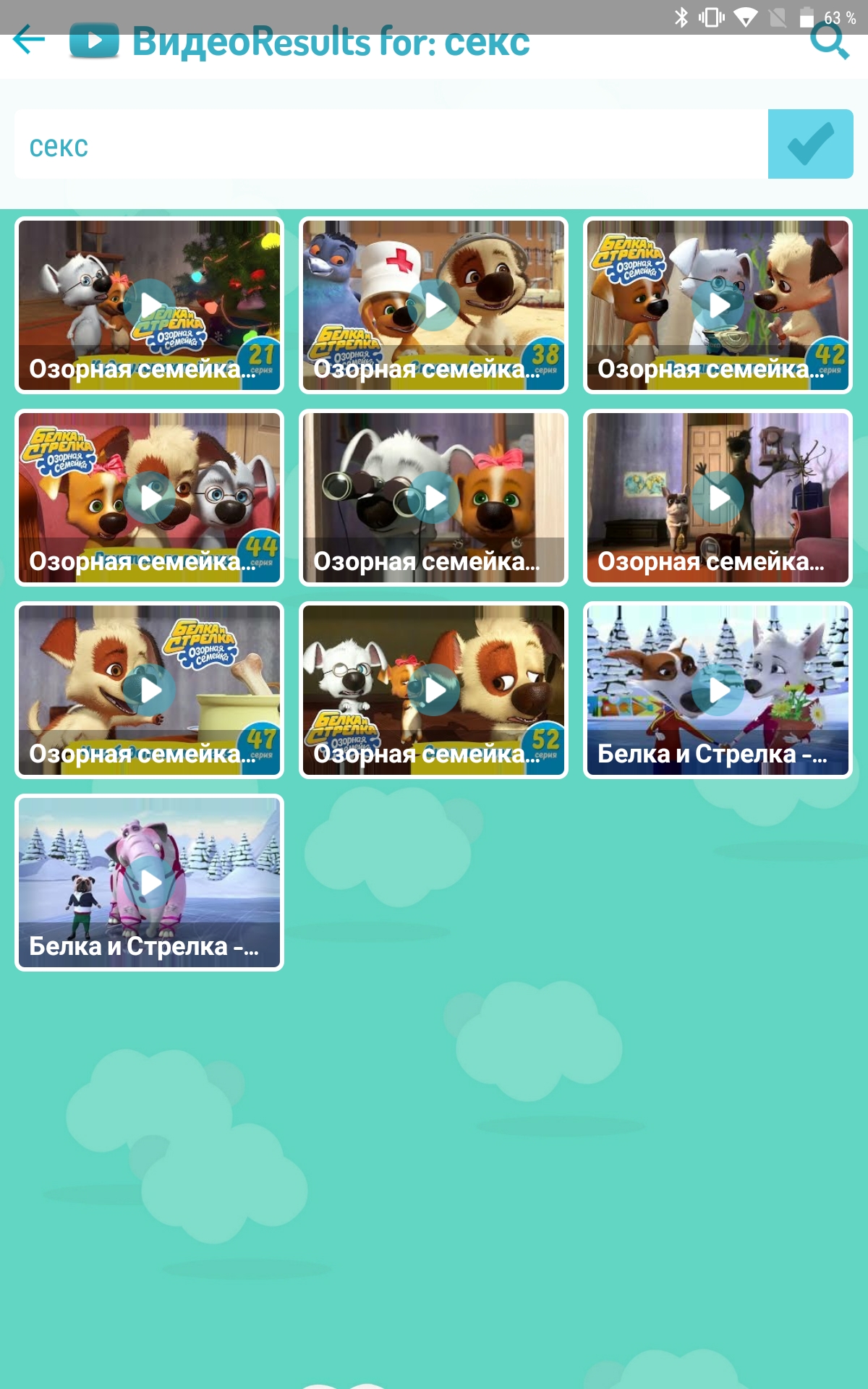 Web sites: a
Web sites: a reduced browser with pre-installed sites like Lego, Disney videos, etc., as well as with the ability to go to the sites from the white list. In principle, it is already possible even on the “children's site” to meet some comment module like Disquss and unwanted comments themselves, but let's be honest - it is almost impossible not to meet them :)
Camera: in fact, a camera that allows you to take a picture on the device's camera. In the adjacent label are the photos themselves.
The approach with different accounts is convenient because when a child asks for a tablet, you do not need to delete something (be it browser tabs, photos, messages, dropbox applications, etc.). You can not worry that it will close something yours, will send, will delete, will move, will disconnect. There will also be order with photos: children's photos in one place, yours in another.
Children in the grid: do you need a tablet
It cannot be said that gadgets definitely have a good or bad effect on children (research on this issue can be found in the excellent article on Giktatimes), but, no matter how cool, there are more advantages. Especially given the fact that these children from grade 1 will have to communicate with such a technique, and possession of it will soon be the same mandatory skill as reading, writing and counting. So, first about the pros.
For the smallest:
- For the early development of the child, the tablet is a simulator of touch, fine motor skills, attention, and perseverance. Several components work at once: sound, color, sensor and, most importantly, memorization of the order of actions with the device. Tactile, intuitive interface provides comfort when handling the device.
- Developed reaction and coordination of movements. For the reaction, you can use special games and applications, for the development of motor coordination at an early age it is better to use ordinary drawing and coloring. You can give your child the opportunity to draw on the touch screen himself, or you can use ready-made coloring pages where you need to arrange colors with your touch.
- The tablet distracts the child in those moments when it is necessary (during moments of stress, on trips, in the clinic), etc. Yes, they don’t write about this feature in TTX gadgets, but it’s sometimes that it’s the saving one :)
An international JRC study “Preschoolers (0-8) and Digital Technologies” was conducted, in which 70 families, more than 150 children and parents took part. According to the survey, more than 85% of children of this age play online, a little more than 30% watch cartoons and less than 10% receive educational content. In the UK, the most popular resources for this group are as follows: YouTube, CBEEBIES (a specialized children's portal with thoughtful educational content), Angry Birds, Gilt Pappa, Talking Tom, Minecraft. In Russia, the rating, alas, looks more alarming: YouTube, VKontakte, Cut the Rope, Angry Birds, Tap the Frog, Minecraft. As you can see, we have an educational component, video and social networks prevail.
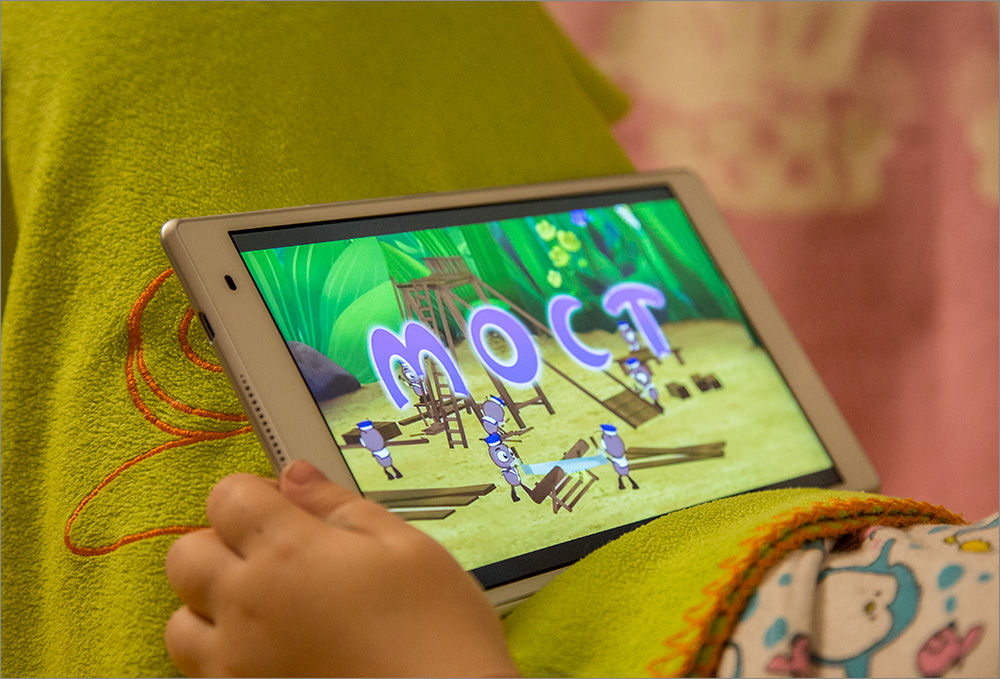
For children of preschool and early school age:
- Developed vocabulary and reading skills. Whatever you say, and interaction with the tablet is more text: search, search on YouTube, chat, chat in social networks. Accordingly, the child quickly masters the keyboard and words so that the device understands it. And you can contribute to this - for example, do not add channels with cartoons to your favorites, and force each time to search for your favorite stories yourself.
- Collaboration skills are being developed - for example, children can work together on homework or share ideas and photographs of handicrafts. It is important that some of the games also contribute to the development of teamwork and distribution skills, rather than shifting responsibility.
- Starting immersion in logic and mathematics (and later chemistry and physics) should also be
fixed with special applications. The fact is that the tablet is perceived by children as a game, and not as a study, which means that knowledge will be learned more easily. For such skills, we need not so much a game, but special logical and mathematical puzzles — there are quite a lot of them in all the stories.
- Similarly, you can do with the English language - in the form of a game will begin to form vocabulary. However, here you need to be alert and at the same time to turn to professional teachers in order to master grammar and, most importantly, phonetics.
- A tablet and a smartphone are, first of all, communication, open communication with voice, video, etc. Accordingly, the gadget is able to compensate for some of the missing communication, for example, during illness. In addition, for children who are forced to spend some time at home or at home, gadgets give a feeling of being among friends and classmates. This is a powerful factor of socialization.
- It is convenient to use the tablet for educational purposes - it can be an element of work in the laboratory, a compass, a map, a diary of observations, etc.
- The tablet can also be an element of child safety. Teach your child to call you on Skype, record video and take photos, let him share with you images. So you will be able to assess the environment surrounding the child when he is at a summer camp, at a sports gathering, or even at a friend's birthday party. The main thing, then do not forget
to remove from the parking brake to stop controlling the grown up child.
How to make both pros and cons more
According to the same survey, 24% of children use the tablet daily, 24% - every other day, 24% - rarely, 8% - only on weekends. In 26% of cases, the child got acquainted with the tablet himself, in 20% - the father taught, in 16% - the mother, in 12% - the brothers and sisters. 42% spinogryzikov from 0 to 8 work with the tablet very confidently, 34% - just confidently and only 8% - uncertainly. More than 80% of the children turned on the tablet themselves, 55% unlocked, 82% scrolled through the menus and found the buttons of familiar applications, 20% started using unfamiliar applications.
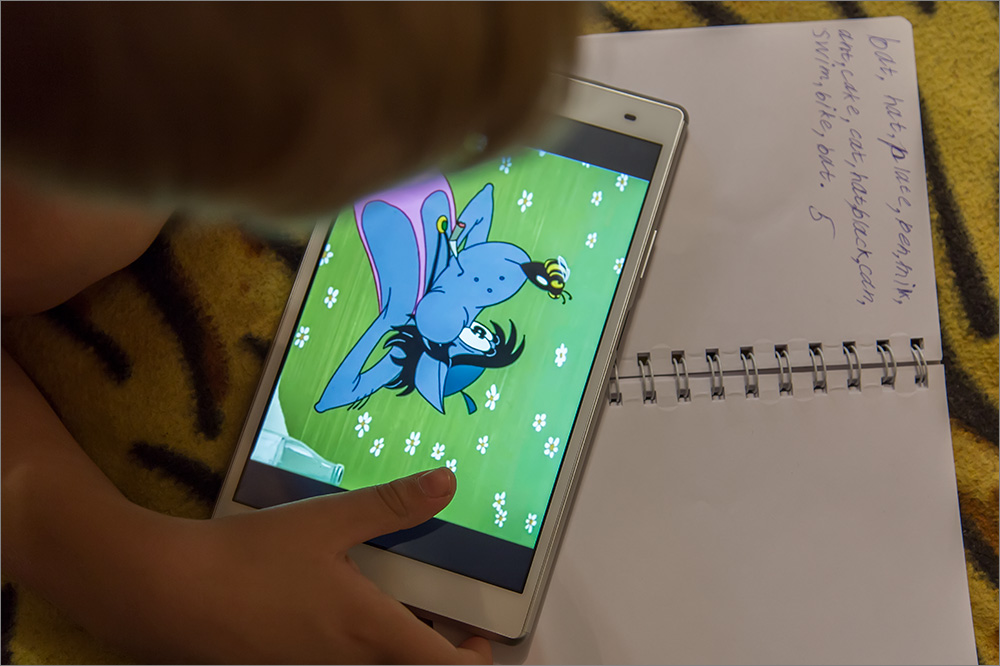
In order to smooth out the possible negative consequences of a child working with a tablet, you need to follow a simple rule: participate in the process yourself.
- It is believed that when children are fixed on the screen, they do not use the environment, do not explore it, lose their creative skills, and their imagination suffers. Adults are able to deal with these side effects - just enough to control the quality and usefulness of consumed content. Presented in the tablet from the review shell KIDOZ in this regard provides a very high-quality content (especially for young children).
- Depending on the age, set the standards for working with the tablet. For example, for children under three years old, these should be only separate distractions, and for older preschool children, about two hours a day. This function in the tablet is also available.
- Do not allow bad habits to form - remove the gadgets a couple of hours before bedtime and categorically ban them for food (here and household interest - there will be more purpose). Here the tablet software is unlikely to help - first of all it is a question of education.
- Broadcast tasks from the screen into reality. I looked at the cartoon - let him retell the content, play the game with sorting or grouping objects - let him sort the clothes before washing, feed the virtual animal - time to walk with the dog and play with the cat, etc. This will give an additional important skill: to use knowledge in practice, to see the connection between the virtual and the real world.
- The most unpleasant problem associated with the use of the tablet is reduced physical activity, which can lead to excess weight, decreased muscle tone, growth retardation, and even depression. The rule is simple: by example and joint actions demonstrate that sports and physical education are much more interesting than a tablet. Of course, if you chop at WoT, eating pizza, and make the child jump rope, this situation will look like punishment and cause a wild protest.
- Another is not a vain accusation: the tablet can cause some harm to children's eyes. Of course, loss of vision is more likely a myth, but fatigue and redness are a very reality. In addition to the limitations in time and intensity of use, technical solutions will help, for example, special stickers on the display. But the basic advice - to comply with the screen brightness mode, you can manually, or better in automatic mode.
- Often, gadgets are blamed on the destruction of the emotional connection between children and parents. Of course, if everyone at the table is buried in gadgets or disperses on sofas, then there will be no emotional connection. But if you support the child, work and play together, develop imagination and thinking, then the connection will only get stronger.
- And of course, moderate content consumed within the age and reasonable range - it’s difficult to master National Geografic films at 4 years old, and at 12 it’s foolish to limit interests to Luntik, Smeshariki and Pig Peppoy - be sure that everything that is under-received is more than compensated by classmates. Only in a painful, perverted form. Therefore, learn to be friends and trust - otherwise you risk getting a reticent, secretive and inside a very sad teenager, and then an adult son or daughter instead of a native child.
Total
In general, tablets should not be demonized, they are very harmless and even useful if you follow the simple rules that we told you about. Of course, you can protect a child from everything, make friends with books, control every step - no one has the right to condemn parents. But still agree that tabooing a computer in the 21st century is a sign of a medieval person.

The new Lenovo Tab 4 8 Plus is, first of all, an “adult” tablet, which, however, can be used not by one person, but by several, including children (including small ones). Therefore, the tablet is quite a pulls on the title of "family": the mother will be able to watch on it serials and recipes, to pop on Skype; Dad - watch Peppa's pig so that no one will know about it, and children - watch Peppa's pig so that parents will be aware of this and will not worry again. And the original "children's" accessories for such a multiplayer mode here is very useful.
Thanks for attention!